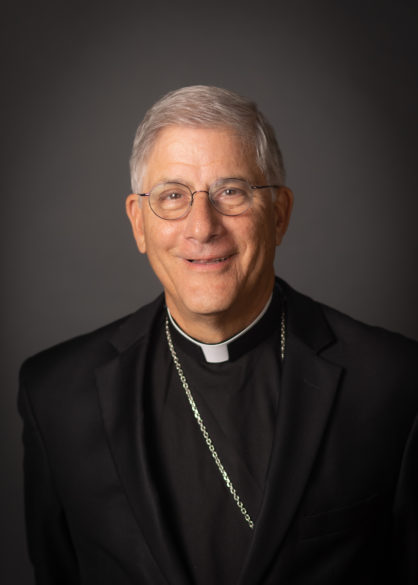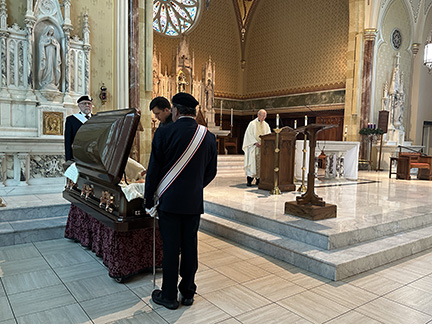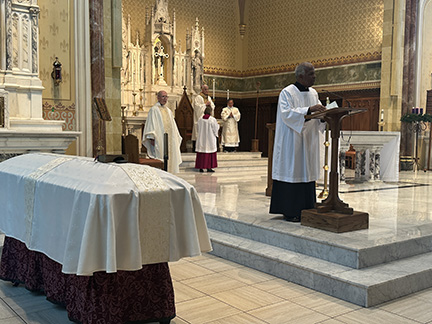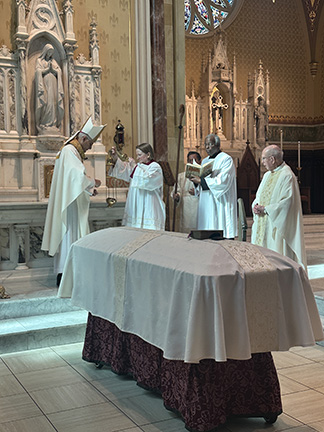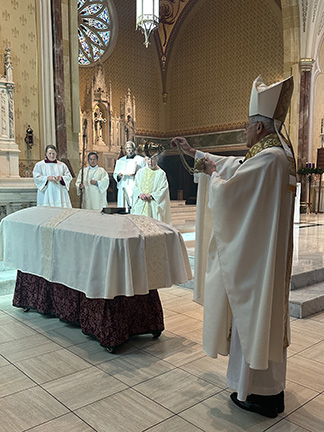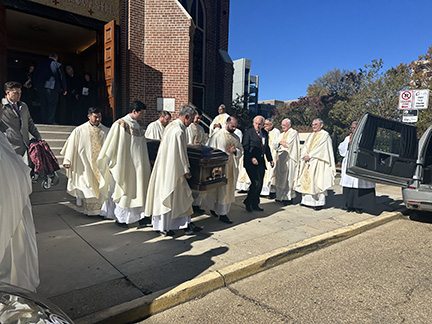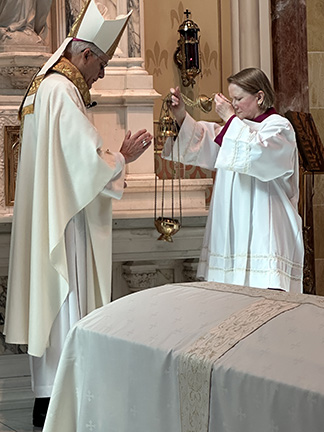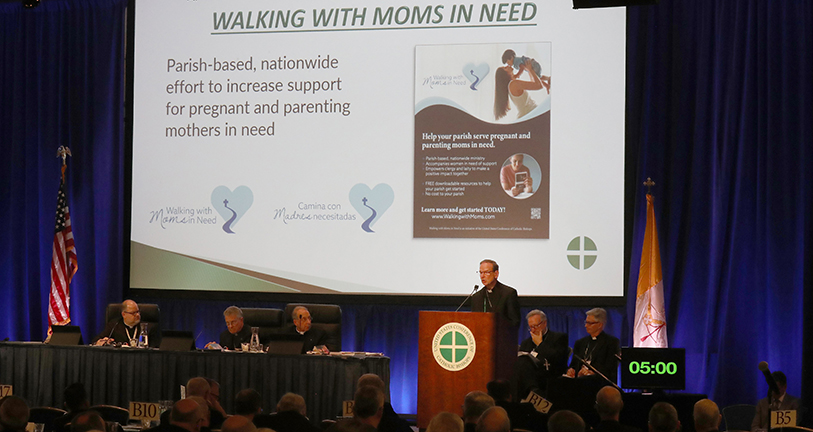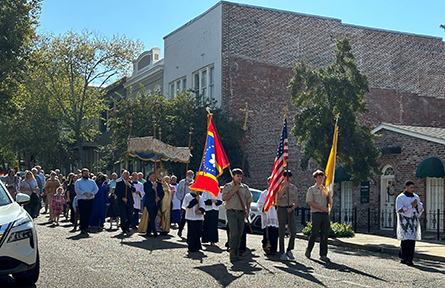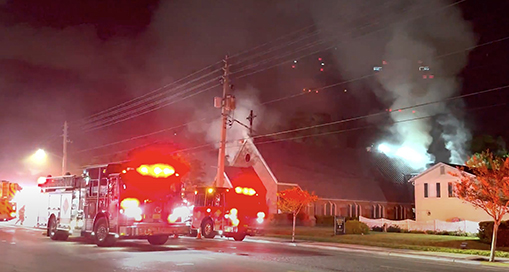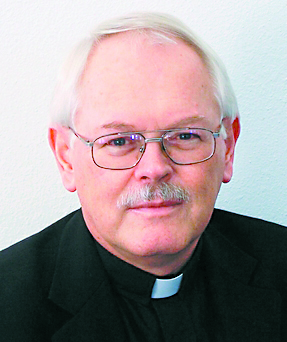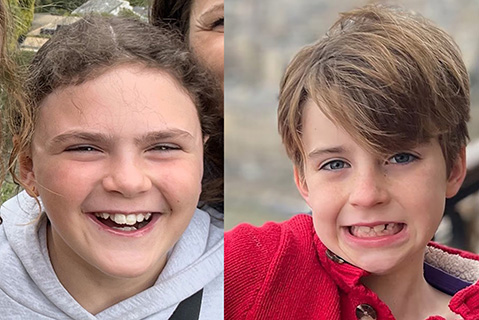
NACIÓN
MINNEAPOLIS (OSV News) – Fletcher Merkel, de ocho años, “amaba a su familia, a sus amigos, la pesca, la cocina y cualquier deporte que se le permitiera practicar”, y el vacío que su muerte ha dejado en los corazones de su familia nunca se llenará, comentó su padre en una conferencia de prensa celebrada el 28 de agosto frente a la escuela Annunciation School de Minneapolis. Harper Moyski, de diez años, era una hermana mayor “alegre”, “brillante” y “muy querida”, según declaró su familia en un comunicado el 29 de agosto. Fletcher y Harper fueron confirmados como víctimas del tiroteo del 27 de agosto en la iglesia católica Annunciation. Las familias de los dos niños asesinados han hablado públicamente por primera vez. Conteniendo las lágrimas, el padre de Fletcher, Jesse Merkel, dijo que nunca se les permitiría “verlo convertirse en el maravilloso joven en el que se estaba convirtiendo”. Merkel también expresó su gratitud por “las rápidas y heroicas acciones de niños y adultos por igual” dentro de la iglesia. “Por favor, recuerden a Fletcher por la persona que era y no por el acto que acabó con su vida”, añadió. Los papás de Harper, Michael Moyski y Jackie Flavin, describieron a su hija como “brillante, alegre y profundamente querida”, y dijeron en un comunicado: “Nuestros corazones están destrozados no solo como papás, sino también por la hermana de Harper”. Hicieron un llamamiento a la acción, instando a los líderes y a las comunidades a abordar la violencia armada y la salud mental. “La luz de Harper siempre brillará a través de nosotros, y esperamos que su recuerdo inspire a otros a trabajar por un mundo más seguro y compasivo”, dijeron.
ORANGE COUNTY, Calif. (OSV News) – Las autoridades policiales arrestaron a un hombre de Alabama después de que presuntamente profiriera amenazas criminales contra una iglesia del condado de Orange, y se encontrara en su vehículo un alijo de municiones y chalecos antibalas, según informaron las autoridades el 2 de septiembre. El Departamento del Sheriff del condado de Orange dijo que sus investigadores fueron contactados el 28 de agosto por un sacerdote “en relación con correos electrónicos sospechosos y amenazantes” enviados a la abadía de San Miguel de la orden norbertina en Silverado Canyon. Afirmaron que el sospechoso, Joshua Michael Richardson, de 38 años, residente en Alabama, “primero envió correos electrónicos que se interpretaron como amenazantes”, antes de visitar la iglesia “en persona y proferir nuevas amenazas”. La Diócesis de Orange no respondió de inmediato a una solicitud de comentarios de OSV News. El Departamento del Sheriff del Condado de Orange dijo que sus investigadores y agentes “localizaron y detuvieron rápidamente a Richardson por amenazas criminales” y que posteriormente encontraron chalecos antibalas, cargadores de alta capacidad, nudillos de bronce y cuchillos tras registrar su vehículo. “Agradecemos a las autoridades su rápida actuación para garantizar la seguridad de nuestra comunidad parroquial”, dijo Jarryd Gonzales, jefe de comunicaciones de la Diócesis Católica de Orange. Refiriéndose al reciente tiroteo masivo en una iglesia católica de Minneapolis, añadió: “Nuestras parroquias y escuelas siguen reforzando las medidas de seguridad”.
VATICANO
CIUDAD DEL VATICANO (CNS) – El papa León XIV ha hecho un llamado a los líderes beligerantes de Sudán para que negocien la paz y permitan que la ayuda llegue a la población civil. “En El Fasher, muchos civiles están atrapados en la ciudad, víctimas del hambre y la violencia”, dijo el 3 de septiembre, citando también un deslizamiento de tierra mortal y la propagación del cólera. Instó a la comunidad internacional a abrir corredores humanitarios y detener la catástrofe.
MUNDO
MANAGUA, Nicaragua (OSV News) – Un nuevo informe indica que los ataques contra la Iglesia católica en Nicaragua han disminuido considerablemente en 2025, pero esta disminución no significa que el gobierno haya suavizado su represión. La abogada e investigadora exiliada Martha Patricia Molina, autora del informe “Nicaragua, una Iglesia perseguida”, afirmó que este año solo se han documentado 32 agresiones, frente a las más de 300 registradas en 2023. Desde 2018, ha contabilizado más de 1000 incidentes, que van desde el acoso al clero hasta la confiscación de escuelas y organizaciones benéficas. Molina afirmó que la disminución del número de ataques en 2025 no significa que se esté “estableciendo una relación cordial” entre la dictadura y la Iglesia. Por el contrario, dijo, “el clero no puede denunciar bajo ninguna circunstancia los abusos y la vigilancia diaria a los que está sometido”. Cientos de clérigos y religiosos permanecen en el exilio, entre ellos cuatro obispos. En agosto, el papa León XIV recibió a tres de ellos en una audiencia privada en el Vaticano, un gesto que, según los observadores, reafirma el apoyo papal a los obispos nicaragüenses en conflicto. La Iglesia católica ha sufrido una intensa persecución desde 2018, cuando las parroquias y universidades dieron refugio a los manifestantes en sus instalaciones para protegerlos de la policía y los paramilitares, y posteriormente acompañaron a las familias de los presos políticos.
PORT-AU-PRINCE, Haiti (OSV News) – Una misionera irlandesa secuestrada en Haití ha sido liberada tras casi un mes de cautiverio. Gena Heraty, que lleva tres décadas trabajando en Haití, fue secuestrada el 3 de agosto cuando unos hombres armados irrumpieron en el orfanato Saint-Hélène, cerca de Puerto Príncipe. Heraty y varias otras personas, entre ellas un niño de tres años con discapacidad, se encuentran ahora a salvo y reciben atención médica y psicológica. La Agencia Fides, una rama informativa del Dicasterio para la Evangelización, confirmó la liberación el 1 de septiembre. Heraty dirige el orfanato, que forma parte de una red internacional que atiende a niños vulnerables en toda América Latina. Su familia expresó su “profunda gratitud” por las oraciones y los esfuerzos mundiales que lograron su liberación, al tiempo que pidió privacidad mientras se recupera. El viceprimer ministro irlandés, Simon Harris, había pedido su liberación inmediata, elogiando su dedicación de toda la vida a los pobres de Haití cuando fue secuestrada. El secuestro pone de relieve el agravamiento de la crisis en Haití, donde las pandillas controlan la mayor parte de la capital y millones de personas se enfrentan a una grave hambruna. Los líderes de la Iglesia advierten que la escalada de violencia está paralizando la labor pastoral y humanitaria. Entre principios de abril y finales de junio, la violencia armada en Haití ha causado la muerte de 1520 personas y heridas a otras 609, según un nuevo informe sobre los derechos humanos en Haití publicado el 1 de agosto por la ONU.

